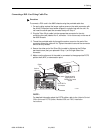
2. Installation
2-14 July 2003 8620-A2-GN20-40
Installing the Cards
Use a small- to medium-size Phillips screwdriver to install the SCP, MCP, SCM,
and DSL cards. If used:
n An SCP card must be installed in Slot A. Do not attempt to insert an SCP
card into any slot other than Slot A.
n An SCM card must be installed in Slot A. Do not attempt to insert an SCM
card into any slot other than Slot A.
n An MCP card must be installed in Slot 1. Do not attempt to insert an MCP
card into any slot other than Slot 1. Only use the MCP card in an 8620
chassis. Do not try to use an MCC or MCC Plus card, as they are
designed for a different chassis.
A DSL port card or MCP card may be replaced without disruption to user data (that
is, you can remove and reinstall a card without powering down the 8620 chassis
and disrupting user data on the other cards). To remove the port card or the MCP
card from the chassis, unfasten the screws on both ends of the faceplate. Then,
simply push the ejector handles outward and slide the card out. To remove an
SCP or SCM card, unscrew both ends of the card’s faceplate, then pull the levers
inward and slide the card out.
Removing an SCP or SCM card disrupts data on the DSL port cards.
When swapping a new card for an old card, it is important to note that the Hotwire
8620 GranDSLAM retains the Media Access Control (MAC) address, also referred
to as the physical address. This means that the new card will have the same MAC
address as the old one. If you need to refer to the MAC address, it is printed on the
SIM card. You must remove the SCP or SCM card from the chassis to see the
MAC address printed on the SIM card.
NOTE:
Do not discard filler plates. Each slot in the chassis must contain a circuit card
or a filler plate to maintain the required EMI shielding and to prevent air
leakage from the forced air cooling. Air leakage could result in overheating
which may cause the power to the circuit cards to be shut off. Store all unused
filler plates in a safe place. You may need to use the filler plates to cover open
slots in the chassis at a later time.


















